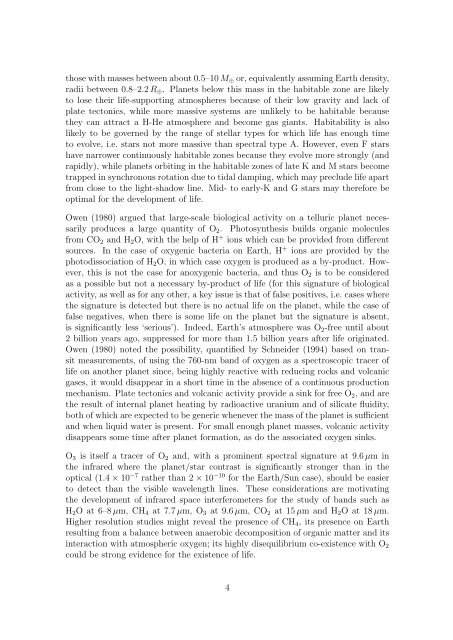Report - School of Physics
Report - School of Physics
Report - School of Physics
Create successful ePaper yourself
Turn your PDF publications into a flip-book with our unique Google optimized e-Paper software.
those with masses between about 0.5–10 M ⊕ or, equivalently assuming Earth density,<br />
radii between 0.8–2.2 R ⊕ . Planets below this mass in the habitable zone are likely<br />
to lose their life-supporting atmospheres because <strong>of</strong> their low gravity and lack <strong>of</strong><br />
plate tectonics, while more massive systems are unlikely to be habitable because<br />
they can attract a H-He atmosphere and become gas giants. Habitability is also<br />
likely to be governed by the range <strong>of</strong> stellar types for which life has enough time<br />
to evolve, i.e. stars not more massive than spectral type A. However, even F stars<br />
have narrower continuously habitable zones because they evolve more strongly (and<br />
rapidly), while planets orbiting in the habitable zones <strong>of</strong> late K and M stars become<br />
trapped in synchronous rotation due to tidal damping, which may preclude life apart<br />
from close to the light-shadow line. Mid- to early-K and G stars may therefore be<br />
optimal for the development <strong>of</strong> life.<br />
Owen (1980) argued that large-scale biological activity on a telluric planet necessarily<br />
produces a large quantity <strong>of</strong> O 2 . Photosynthesis builds organic molecules<br />
from CO 2 and H 2 O, with the help <strong>of</strong> H + ions which can be provided from different<br />
sources. In the case <strong>of</strong> oxygenic bacteria on Earth, H + ions are provided by the<br />
photodissociation <strong>of</strong> H 2 O, in which case oxygen is produced as a by-product. However,<br />
this is not the case for anoxygenic bacteria, and thus O 2 is to be considered<br />
as a possible but not a necessary by-product <strong>of</strong> life (for this signature <strong>of</strong> biological<br />
activity, as well as for any other, a key issue is that <strong>of</strong> false positives, i.e. cases where<br />
the signature is detected but there is no actual life on the planet, while the case <strong>of</strong><br />
false negatives, when there is some life on the planet but the signature is absent,<br />
is significantly less ‘serious’). Indeed, Earth’s atmosphere was O 2 -free until about<br />
2 billion years ago, suppressed for more than 1.5 billion years after life originated.<br />
Owen (1980) noted the possibility, quantified by Schneider (1994) based on transit<br />
measurements, <strong>of</strong> using the 760-nm band <strong>of</strong> oxygen as a spectroscopic tracer <strong>of</strong><br />
life on another planet since, being highly reactive with reducing rocks and volcanic<br />
gases, it would disappear in a short time in the absence <strong>of</strong> a continuous production<br />
mechanism. Plate tectonics and volcanic activity provide a sink for free O 2 , and are<br />
the result <strong>of</strong> internal planet heating by radioactive uranium and <strong>of</strong> silicate fluidity,<br />
both <strong>of</strong> which are expected to be generic whenever the mass <strong>of</strong> the planet is sufficient<br />
and when liquid water is present. For small enough planet masses, volcanic activity<br />
disappears some time after planet formation, as do the associated oxygen sinks.<br />
O 3 is itself a tracer <strong>of</strong> O 2 and, with a prominent spectral signature at 9.6 µm in<br />
the infrared where the planet/star contrast is significantly stronger than in the<br />
optical (1.4 × 10 −7 rather than 2 × 10 −10 for the Earth/Sun case), should be easier<br />
to detect than the visible wavelength lines. These considerations are motivating<br />
the development <strong>of</strong> infrared space interferometers for the study <strong>of</strong> bands such as<br />
H 2 O at 6–8 µm, CH 4 at 7.7 µm, O 3 at 9.6 µm, CO 2 at 15 µm and H 2 O at 18 µm.<br />
Higher resolution studies might reveal the presence <strong>of</strong> CH 4 , its presence on Earth<br />
resulting from a balance between anaerobic decomposition <strong>of</strong> organic matter and its<br />
interaction with atmospheric oxygen; its highly disequilibrium co-existence with O 2<br />
could be strong evidence for the existence <strong>of</strong> life.<br />
4
















